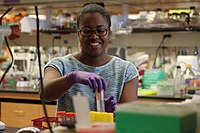
Photo from wikipedia
Substantial guidance is available on undergraduate quantitative training for biologists, including reports focused on biomedical science. Far less attention has been paid to the graduate curriculum and the particular challenges… Click to show full abstract
Substantial guidance is available on undergraduate quantitative training for biologists, including reports focused on biomedical science. Far less attention has been paid to the graduate curriculum and the particular challenges of the diversity of specialization within the life sciences. We propose an innovative approach to quantitative education that goes beyond recommendations of a course or set of courses or activities, derived from analysis of the expectations for students in particular programs. Due to the plethora of quantitative methods, it is infeasible to expect that biomedical PhD students can be exposed to more than a minority of the quantitative concepts and techniques employed in modern biology. We collected key recent papers suggested by the faculty in biomedical science programs, chosen to include important scientific contributions that the faculty consider appropriate for all students in the program to be able to read with confidence. The quantitative concepts and methods inherent in these papers were then analyzed and categorized to provide a rational basis for prioritization of those concepts to be emphasized in the education program. This novel approach to prioritization of quantitative skills and concepts provides an effective method to drive curricular focus based upon program-specific faculty input for science programs of all types. The results of our particular application to biomedical science training highlight the disconnect between typical undergraduate quantitative education for life science students, focused on continuous mathematics, and the concepts and skills in graphics, statistics, and discrete mathematics that arise from priorities established by biomedical science faculty. There was little reference in the key recent papers chosen by faculty to classic mathematical areas such as calculus which make up a large component of the formal undergraduate mathematics training of graduate students in biomedical areas.
Journal Title: PLOS ONE
Year Published: 2023
Link to full text (if available)
Share on Social Media: Sign Up to like & get
recommendations!